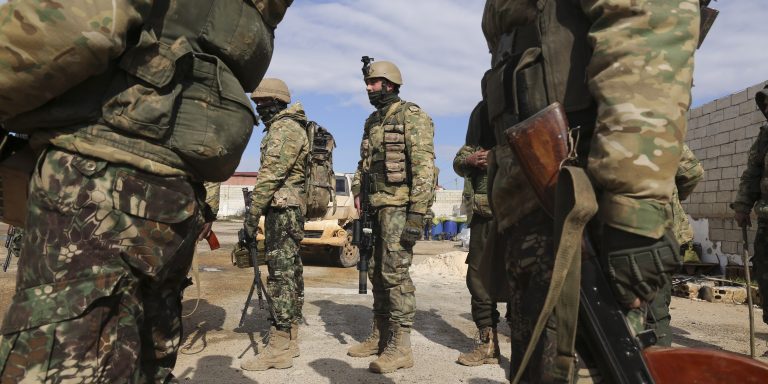INTELBRIEF
February 12, 2020
IntelBrief: Conflict in Idlib Escalates Between Turkey and Syria While Civilians Suffer

- The nine year-long Syrian civil war continues to rage, with most of the intense fighting taking place in northwestern Syria in Idlib Province.
- Hay’at Tahri al-Sham, one of the most powerful rebel groups still fighting in Syria, released video footage yesterday of what it claims is its fighters shooting down a Syrian regime helicopter over Nayrab in southern Idlib.
- Overlooked amidst the reporting on military clashes has been the civilian toll of suffering and displacement, which has reached staggering new levels.
- Approximately 700,000 people have been displaced from Idlib since December 2019 and hundreds of civilians have been killed; an estimated 5.5 million of Syria’s 17 million people are now living as refugees.
.
The Syrian civil war continues to rage, with most of the intense fighting taking place in northwestern Syria in Idlib Province. Earlier this week, Syrian regime troops unleashed an artillery bombardment against a military base in Idlib that led to the deaths of five Turkish soldiers. Last week, Turkey lost eight soldiers to a Syrian offensive in Saraqeb, south of Taftanaz. Ankara responded by attacking over 100 regime targets. Turkey has deployed tanks, armored vehicles, rocket launcher systems, and paratroopers into Idlib in the past week alone. And while Ankara may look to Moscow to lean on Damascus to calm tensions, there are few signs of an imminent cessation of hostilities. The situation is escalating rapidly and both sides have pledged to continue fighting, blaming the other for the most recent cycle of violence.
Hay’at Tahri al-Sham (HTS), one of the most powerful rebel groups still fighting in Syria, released video footage yesterday of what it claims is its fighters shooting down a Syrian regime helicopter over Nayrab in southern Idlib. While Turkey prefers to support rebels from the National Liberation Front (NLF) and the Syrian National Army (SNA), HTS remains an effective fighting force. Turkey has supplied its proxies with a range of weaponry, including small-arms, mortars, and anti-tank guided missiles (ATGMs). There are growing concerns that the chaos in northwestern Syria is allowing the al-Qaeda-linked Hurras al-Din (HAD) to rebuild its network, one that could potentially seek to launch external operations against the West. HTS is thought to have somewhere between 12,000 to 15,000 fighters under arms while HAD is estimated at between 3,500 and 5,000 militants. According to a recent report by the United Nations Security Council, Islamic State militants have also relocated from other parts of Syria to Idlib, where the group maintains resources and facilities. Abu Bakr al-Baghdadi, the leader of the Islamic State, was hiding in Barisha, in Idlib Province, when he was killed in an October 2019 raid by U.S. Special Operations Forces.
U.S. Special Representative for Syria Engagement and Special Envoy for the Global Coalition to Defeat ISIS Ambassador James Jeffrey was dispatched this week to Turkey to hold discussions over the current fighting in Idlib. Despite Ankara’s warming relationship with Moscow over the past year, including its decision to move forward with purchasing Russia’s S-400 missile system in a direct rebuke to NATO, Turkey and Russia still find themselves on opposite sides in several ongoing conflicts, including Syria and Libya. Russia has demanded that Turkey refrain from further attacks on Russian forces and allies. And while friction between Erdogan and Putin over Idlib could provide an opening for Washington, U.S. leadership on the conflict in Syria has dramatically diminished, and U.S. support for the Syrian Democratic Forces (SDF) remains a major point of disagreement between the United States and Turkey.
Overlooked amidst the reporting on military clashes has been the civilian toll of suffering, which has reached staggering new levels. The United Nations (UN) Office for the Coordination of Humanitarian Affairs (OCHA) released a statement recently declaring that more Syrian civilians had fled fighting in the last ten weeks than at any previous point during the now nine-year long civil war. The scale of human suffering is staggering, with indiscriminate shelling by the Syrian military and Russian airstrikes devastating civilian populations and what little remains of a functioning infrastructure. The Assad regime is determined to seize control of several highways that link Aleppo to other areas controlled by the government. Approximately 5.5 million of Syria’s 17 million people are now living as refugees, with the recent fighting in Idlib expected to contribute to that number by as many as an additional 300,000 people in the near term. Over the course of the Syrian civil war, Idlib’s population has reached 3 million people, as refugees and internally displaced persons have been pushed into the northwest corner of the country. Approximately 700,000 people have been displaced since December 1, 2019 and hundreds of civilians have been killed.
.
For tailored research and analysis, please contact: info@thesoufancenter.org